All About the History of Chinese Astronomy
The Beginnings of Chinese Astronomy
Ancient Chinese astronomy was centered around a complex system of mathematics and observation of the heavens. Looking at stars for instance, the Chinese paid a great deal of attention to stars that were around the celestial pole. This is because these stars never rose or set allowing Chinese astronomers to position other celestial bodies in the heavens in direct opposition to the Sun. A fair amount of the information we have collected about ancient Chinese astronomy comes from objects found in China known as oracle bones. First, we will take a look at what story the oracle bones have to tell.
Oracle Bones
Oracle bones are fragments of animal bones, and many times tortoise shells that have been heated, cracked and then inscribed to record historical information of Chinese dynasties, such as the Shang Dynasty. Many significant astronomical observations and events were recorded on oracle bones to ensure that a historical record was kept. An oracle bone dating from before 1281 BCE, mentions stars by their names. Another oracle bone records an eclipse from 1281 BCE. Others recorded the passing of comets and novae. One analysis done on an oracle bone dating from the time of the Shang Dynasty of the fourteenth century BCE revealed a lunisolar calendar with intercalary months added to it. Oracle bones were also used for divination purposes.
Star Maps
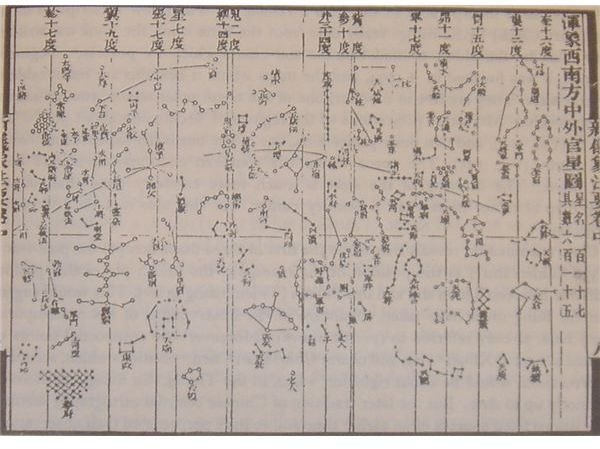
The tradition of drawing star maps in China is very old. Ancient Chinese astronomers used to observe the heavens for astronomical phenomenon. Events such as sunspots, the aurora borealis or the passing of a comet, were considered as omens and were associated with the star regions in which they were spotted. They were then associated with various regions of the Earth, from cities, territories to even parts of the Imperial Palace.
The earliest known star maps in China date back to the fourth century BCE, when three astronomers, Wu Hsien, Kan Te and Shih Shen drew up their maps. For over a thousand years their works were in use. Chhen Cho combined their works into one single star map seven centuries later. Another astronomer by the name of Chhien Lo-Chih devised a planispheric map in the fifth century BCE, in which the stars were assigned colors. The combined total number of stars from the three lists was an astounding 1,464 stars.
The stars were arranged in groups called “chairs”. The total number of chairs listed by the astronomers was 184. Chairs were assigned names and listed the number of stars that each chair had. Stars that were less significant were also listed in respect to the main star in the chair, and the co-ordinates of the main star were also detailed. The use of something similar to our right ascension was also used for co-ordinates, along with polar distance. An astronomer from the Han Dynasty, Zhang Heng (78-139 AD), catalogued nearly 2500 stars and some 100 different constellations. Clearly, the ancient Chinese had a good knowledge of making star maps.
Astronomical Instruments and Observatories
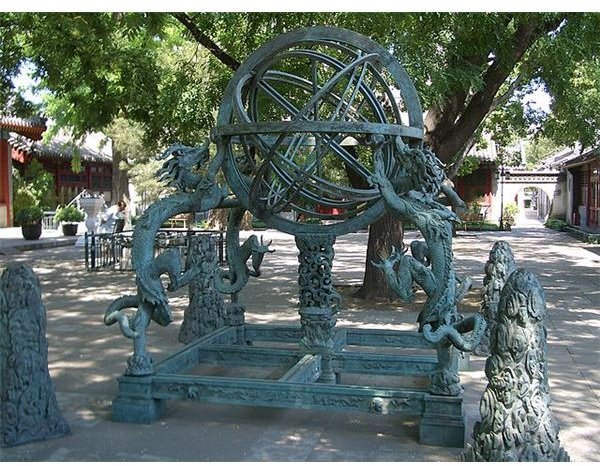
The ancient Chinese used many instruments to keep track of the heavens. One of the astronomical instruments used by the ancient Chinese astronomers was an armillary sphere, used to locate the exact position of a star. Dating back to as early as the fourth century BCE, Chinese astronomers Shi Shen and Gan De were the first in China to develop the armillary sphere. Initially, an armillary sphere consisted of three rings and a metal axis. The rings were each aligned with different regions of the celestial sphere. The outermost ring was aligned with the north and south regions of the sphere, the middle ring was aligned with the equatorial plane of the Earth, while the innermost ring revolved around the axis. The metal axis itself was oriented to face the poles, both north and south. Finding the position of a particular star required pointing the sphere at the star and then reading off the angles from each ring. Zhang Heng is often credited with inventing the world’s first hydraulic armillary sphere.
Another valuable instrument at the disposal of the ancient Chinese was the celestial globe. It was designed to measure the time as well as the azimuths of rising and setting celestial objects. The earliest use of the celestial globe dates back to 1673 AD, during the time of the Qing Dynasty.
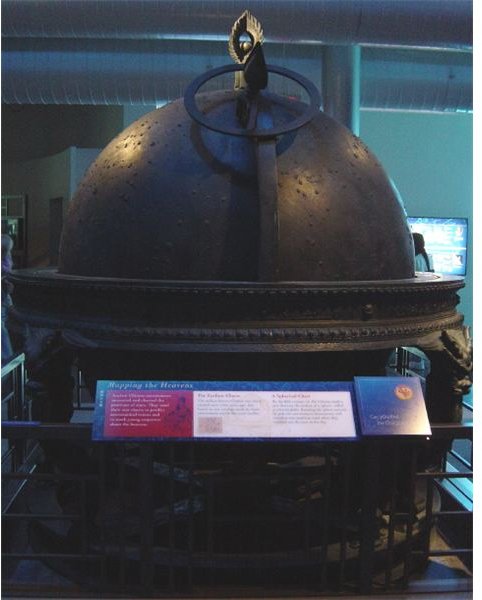
Other instruments of equal value and purpose in ancient Chinese astronomy were the:
- Altazimuth
- Azimuth Theodolite
- Ecliptic Armilla
- Gnomon
- Quadrant and the Sextant
The Beijing Ancient Observatory is one of the oldest observatories in the world. The observatory featured many of the revolutionary tools mentioned above that were developed during the Ming Dynasty and later modified in the Qing Dynasty. The observatory served as a great place for astronomers to conduct research and advanced the field of astronomy in China.
Supernovae
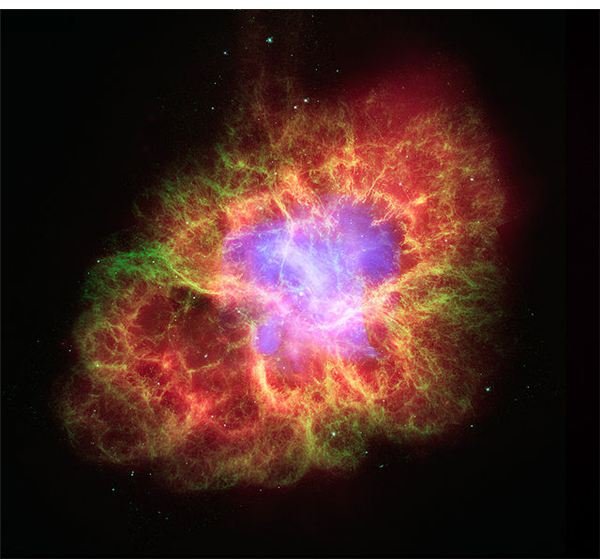
Ancient Chinese astronomers made careful observations of the sky and recorded novae and supernovae starting from 532 BCE. The most famous of their observations was that of a “guest star” in the year 1054 AD. The star was actually a supernova in the constellation Taurus. It was visible from China for 653 days. Records indicate that the supernova observed by the Chinese may also have been witnessed by the Anasazi Indians of North America at around the same time. The remnant of the supernova is today known as the Crab Nebula.
The Song Dynasty
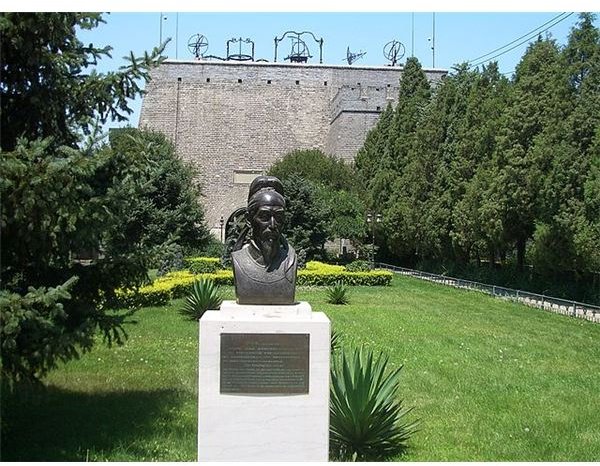
During the period of the Song Dynasty, 960-1279 AD, Chinese astronomy progressed with the rapid building of observatories. Guo Shoujing (1231-1316 AD) emerged from this period as one of the most outstanding astronomers in Chinese history. He perfected the building of a sun dial, and he was able to calculate the length of the year with an error of 30 seconds. Shen Kuo, also from this period, discerned the magnetic declination of the true north with a compass. Su Song was known for his treatise describing his water-powered astronomical clock tower.
Influence of Various Cultures on Chinese Astronomy
The Chinese were great astronomers, but they did have influences from other cultures. For instance, Islamic astronomers came to China during the period of the Mongol empire and the Yuan Dynasty to aid in making calendars. Another aspect of Islamic astronomy that influenced Chinese astronomy was the planetary latitudes theory. Many instruments built by the Chinese show traces of Islamic influence in them. During the period of the Ming Dynasty, Emperor Zhu Yuanzhang ordered that Islamic tables of astronomy be translated into Chinese. The work was carried out subsequently. The tables of sines by the Indian astronomer Aryabhata were also translated into Chinese. Much of the ideas and concepts of Indian astronomy reached China with the spread of Buddhism. European concepts of astronomy eventually reached China, and theories of astronomers such as Copernicus and Kepler eventually found their way into Chinese astronomy.
Present Day Chinese Astronomy
The history of Chinese astronomy is rich and diverse. The ancient Chinese were highly skilled in mathematical astronomy and in keeping track of the heavens. With modern technological advances, China has made great progress in astronomy and space sciences. They currently have a space program that is highly advanced, and are planning on putting a man on the Moon in the not to distant future. Pioneers in many other fields, historically, the Chinese have contributed a great deal to the field of astronomy and continue to do so to the present day.
Credits
1. https://www.chinatoday.com/culture/ancient_beijing_observatory.htm
2. https://hua.umf.maine.edu/China/astronomy/tianpage/0020H_diagram9427w.html
3. https://seds.org/messier/more/m001_sn.html
4. https://www.experiment-resources.com/chinese-astronomy.html
5. “Cosmos: An Ilustrated History of Astronomy and Cosmology”, John David North, University of Chicago Press, 2008
Image Credits: Wikimedia Commons/Rosemania/PericlesofAthens/Vmenkov/Snowdog/https://www.spitzer.caltech.edu/Media/mediaimages/copyright.shtml/Vmenkov
This post is part of the series: Chinese Astronomy
Historically, Chinese astronomers kept track of the stars, the Sun and the Moon for time keeping. They used highly advanced mathematics and constructed elaborated astronomical instruments. We will peer into the workings of early Chinese astronomy and what cultures influenced it the most.
